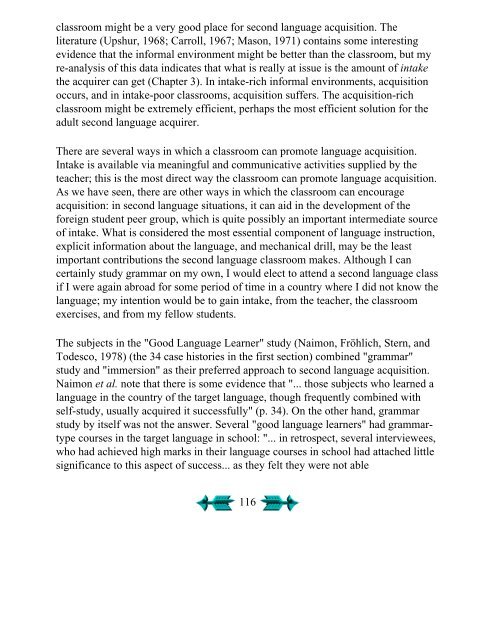Second Language Acquisition and Second ... - Stephen Krashen
Second Language Acquisition and Second ... - Stephen Krashen
Second Language Acquisition and Second ... - Stephen Krashen
You also want an ePaper? Increase the reach of your titles
YUMPU automatically turns print PDFs into web optimized ePapers that Google loves.
classroom might be a very good place for second language acquisition. The<br />
literature (Upshur, 1968; Carroll, 1967; Mason, 1971) contains some interesting<br />
evidence that the informal environment might be better than the classroom, but my<br />
re-analysis of this data indicates that what is really at issue is the amount of intake<br />
the acquirer can get (Chapter 3). In intake-rich informal environments, acquisition<br />
occurs, <strong>and</strong> in intake-poor classrooms, acquisition suffers. The acquisition-rich<br />
classroom might be extremely efficient, perhaps the most efficient solution for the<br />
adult second language acquirer.<br />
There are several ways in which a classroom can promote language acquisition.<br />
Intake is available via meaningful <strong>and</strong> communicative activities supplied by the<br />
teacher; this is the most direct way the classroom can promote language acquisition.<br />
As we have seen, there are other ways in which the classroom can encourage<br />
acquisition: in second language situations, it can aid in the development of the<br />
foreign student peer group, which is quite possibly an important intermediate source<br />
of intake. What is considered the most essential component of language instruction,<br />
explicit information about the language, <strong>and</strong> mechanical drill, may be the least<br />
important contributions the second language classroom makes. Although I can<br />
certainly study grammar on my own, I would elect to attend a second language class<br />
if I were again abroad for some period of time in a country where I did not know the<br />
language; my intention would be to gain intake, from the teacher, the classroom<br />
exercises, <strong>and</strong> from my fellow students.<br />
The subjects in the "Good <strong>Language</strong> Learner" study (Naimon, Fröhlich, Stern, <strong>and</strong><br />
Todesco, 1978) (the 34 case histories in the first section) combined "grammar"<br />
study <strong>and</strong> "immersion" as their preferred approach to second language acquisition.<br />
Naimon et al. note that there is some evidence that "... those subjects who learned a<br />
language in the country of the target language, though frequently combined with<br />
self-study, usually acquired it successfully" (p. 34). On the other h<strong>and</strong>, grammar<br />
study by itself was not the answer. Several "good language learners" had grammartype<br />
courses in the target language in school: "... in retrospect, several interviewees,<br />
who had achieved high marks in their language courses in school had attached little<br />
significance to this aspect of success... as they felt they were not able<br />
116











